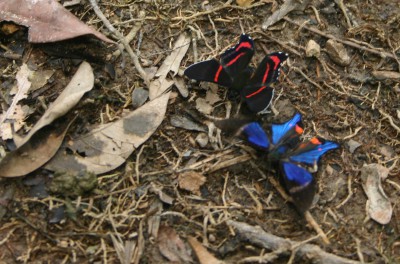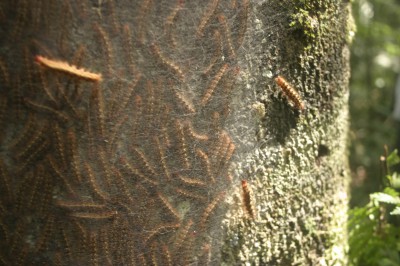 We spend the next few days in the jungle, either cruising
We spend the next few days in the jungle, either cruising
slowly along the river and scanning the sky, the shoreline, the trees and the
water for birds, mammals, fish, reptiles, and insects, or walking in the
rainforest during the day or night. Whether it is day or night, and whether we
are on water or on land, it is immensely satisfying to experience the lush
verdure of the rainforest and to hear the constant symphony of birds, cicadas,
and monkeys. It is altogether quite overwhelming. 
Already on our first day, more than a full page in my
diary gets filled up with the list of the different species we see. Our
adventures begin at sunrise with a ride in the canoe. The morning sun reveals a
myriad of bird life, from tiny hummingbirds (black-throated mango) to groups of
bizarre-looking, clumsy Hoatzin. We see oropendola and their nests. These birds
weave drop-like nests that hang like Christmas decorations from acacia tree
branches. Both the males and the females contribute to building the nests. We
also spot similar nests that are not as pendulous. They are built by
yellow-rumped cacique and are clumped on very thorny palms so no predators can
crawl up to them. We also see a yellow-handed
titi monkey. 
After breakfast on the first day, we go for a walk in
the rainforest and learn about the uses or dangers of the various plants, such
as curare (for dart poison) and quinine (for treating malaria). We also see
lots of interesting spiders, caterpillars, butterflies, ants, frogs, toads, and
orchids.

Some larvae travel up the tree in a group to feed then
back down to bed down for the night. They weave a collective thin covering to
protect themselves, but if they are not home by bedtime, the others will not
let them in. Instead, the latecomers will probably end up as prey. 
Many animals are experts at camouflage so it is a good
thing we have our guide Luis with us to spot the nearly invisible. Can you see
the stick insect in the photo below? Can you see two? A green male is mating a
somewhat larger brown female that looks exactly like a twig. 
We spend our afternoon on the water and see squirrel
monkeys, owl monkeys and birds, birds, birds. I won’t bore you with the list of
about 40 species (!) of hawks, falcons, kingbirds, kingfishers, vultures,
flycatchers, macaws, tanagers, herons, jays and so on that we see this
afternoon. Suffice to say that we see new things at every turn. 
And so the days go watching wildlife. In addition to
what we saw the first day we see countless more birds, including toucans,
parrots and ibis, another river dolphin, a furry-tailed saki monkey, capuchin
monkeys, iridescent butterflies that flap gently in the air like fairy
ballerinas, fireflies, fruit bats, a caiman and a three-toed sloth. Did you that
know that sloths – three-toed sloths in particular – are actually kind of
greenish? They have a complex symbiotic relationship with sloth moths and algae
that grow in their hair.

On one magical evening, we go for a ride in the canoe
to enjoy the sunset in the lagoon. The water level varies up to eight metres
from dry to wet season.

The partly submerged macrolobium trees, that are
reminiscent of African baobab trees, lend an otherworldly appearance to the
scene. As the sun dips towards the horizon everything turns orange. 
My photographs cannot capture the many birds,
half-hidden monkeys or flitting fireflies. Neither can they do justice to how
it actually feels to be here with the
muggy warmth, the symphony of sounds day and night, and the smells of the humid
earth, plants and fragrant flowers.


